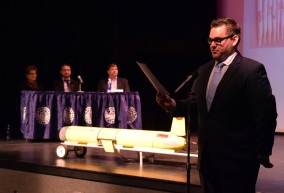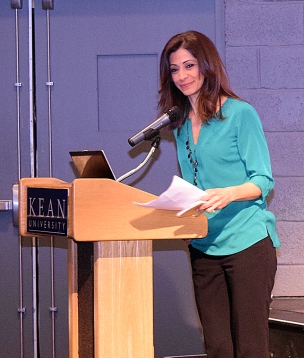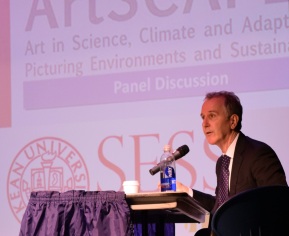Panel on climate change: advocacy, art & science
By: Yuri Smishkewych | Published April 28, 2016
Kean alumni learned and discussed about the science—and art inspired by the science—of climate change at a lecture and panel discussion held at Kean on Apr. 13.
The event, titled “ArtSCAPES – Art in Science, Climate, Change and Adaption: Picturing Environments and Sustainability,” featured five panelists from separate fields of study ranging from fine arts to oceanography to social science and was co-moderated by News12 Meteorologist and Kean alum Michael Favetta (class of ’07) and Lisa Mateo, co-anchor for the PIX 11 Morning News and host of “Celebrity Taste Makers,” who attended Kean for her post-graduate studies.

News12 Meteorologist Mike Favetta at the ArtSCAPES discussion panel & lecture. Photo: Y. Smishkewych
Preceding the two-hour panel discussion, artists Diane Burko and Paula Winokur—whose collaborative exhibit, “Glacial Dimensions,” is on display at Kean’s Burger Gallery—provided a lecture about how their art was inspired by their separate travels to the circumpolar regions where they witnessed the effects of climate change first hand.
“It was cool to see how in-depth the artists went,” said Amy Abdelsayed, a psychology major. “I really liked it.”
Burko and Winokur were then joined on stage by the remaining panelists, Dr. Benjamin Cook, a climate scientist at the NASA Institute for Space Studies, Dr. Joshua Kohurt, an oceangrapher at Rutgers University and Greg Hittelman, the communications director for the Enough Project, a human rights advocacy group co-founded by another familiar name at Kean—John Pendergrast, the Anne Evans Estabrook Human Rights Senior Fellow.
Also on stage was Kohurt’s “friend,” RU15, an autonomous underwater vehicle (AUV) from Rutgers Dept. of Marine and Coastal Sciences that is more akin to an underwater glider than a submarine. According to Kohurt, the AUVs move around or “fly” by changing their buoyancy that causes it to rise or fall in the water and have the capability to travel thousands of miles.

WPIX News Reporter Lisa Mateo. Photo: Y. Smishkewych
“These robots are changing the face of oceanography,” said Kohurt about the data-gathering AUVs that help scientists understand the impacts of climate change in the world’s oceans, “they can fly beneath storms, all around the world, and in challenging environments and don’t put people at risk.”
To demonstrate the effects of climate change from space as gathered by NASA, Cook showed students satellite photographs gathered over a 15 years of the southern U.S., specifically pointing out the effects that three consecutive droughts have had on California in that time.
“We calculated about 11 trillion gallons of water loss in that region,” said Cook about the gathered data, “and we’re starting to see a long-term drying trend in the west since records began.”
Hittelman, of the Enough Project, introduced the geo-political and socio-economic implications that climate change is having and will have in the future and that much can be learned about preventing future atrocities by the experiences learned in areas of conflict across the world, especially Africa.

Greg Hittelman of the Enough Project. Photo: Y. Smishkewych
He also explained the importance of an individual advocate at the micro level as part of the ‘larger picture.’ “When you join a movement,” said Hittelmen, “you’ll be shocked at just how much one person can do.”
The ArtSCAPES project was held and organized by Kean’s School of Environmental and Sustainability Sciences.
Yuri Smishkewych may be reached at ysmishke@kean.edu.
Follow The Tower on Twitter @KeanTower. Find The Tower on Facebook.

You must be logged in to post a comment.